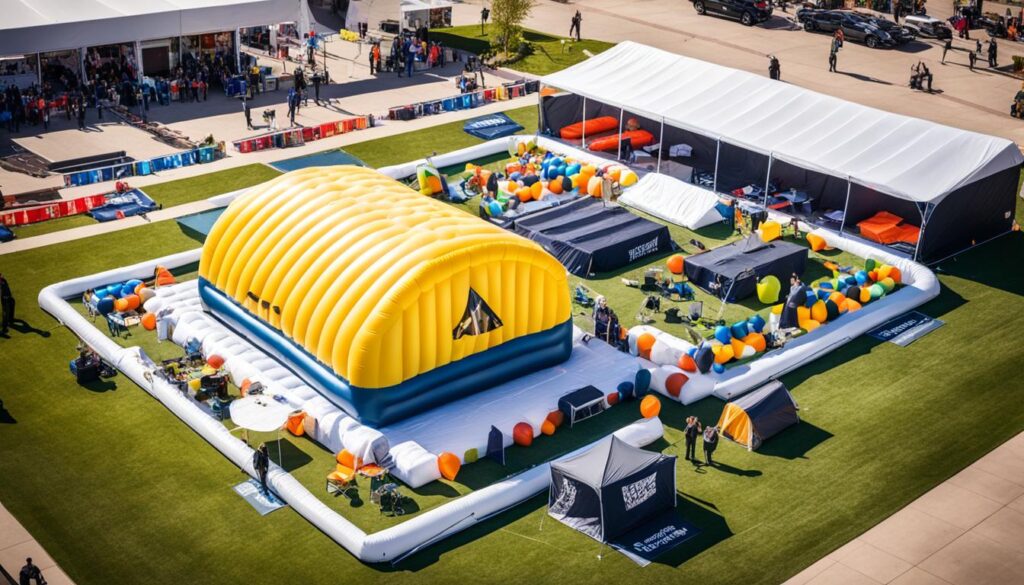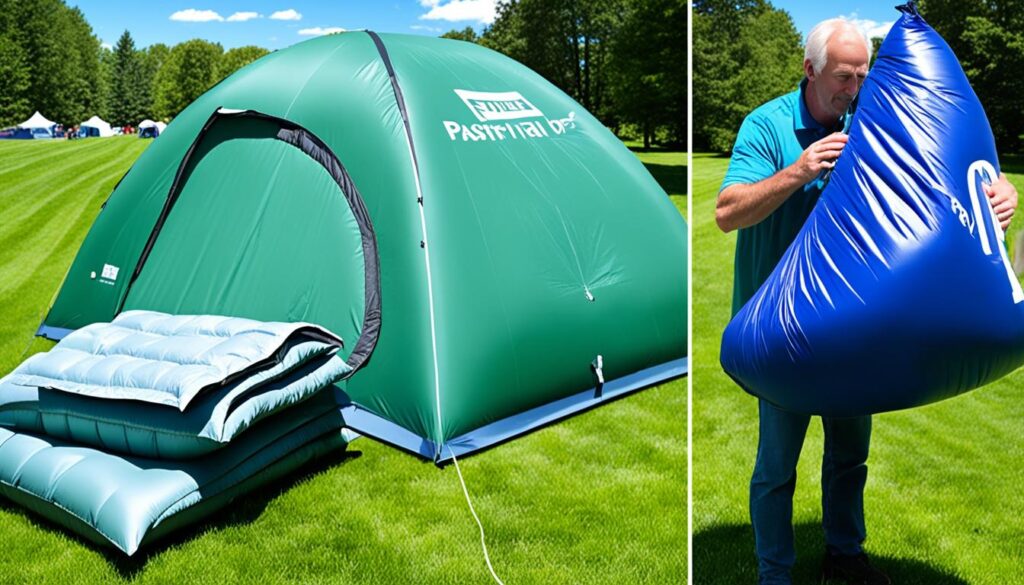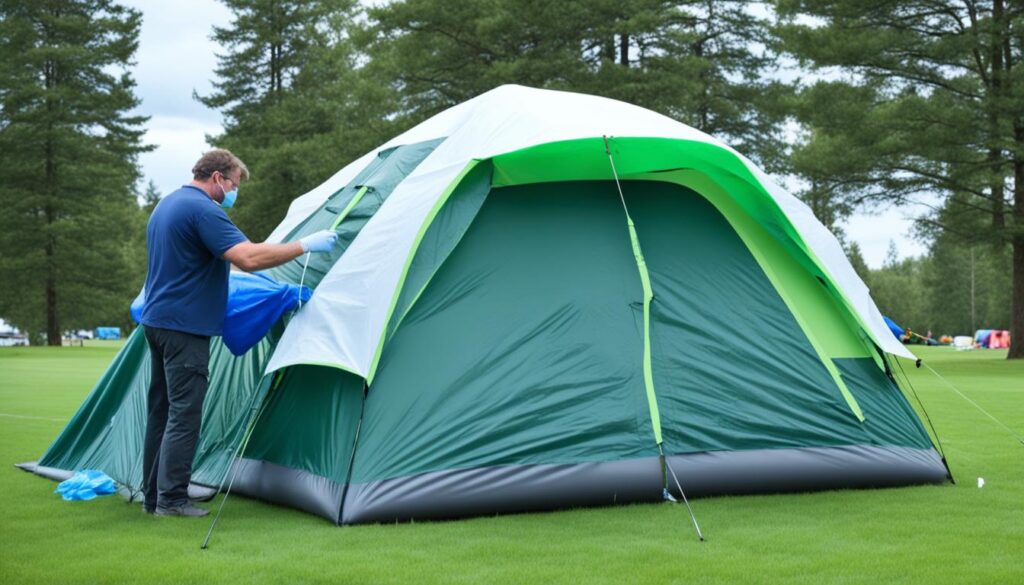
Imagine this: you’re on a camping trip with your closest friends, surrounded by breathtaking scenery and the soothing sounds of nature. You’re excited to spend quality time together, share stories around the campfire, and create lasting memories. But as you step into your inflatable tent, you’re greeted with a cluttered mess that leaves you feeling cramped and disorganized.
Don’t let a lack of space hinder your camping experience. With the right layout tips and organizing solutions, you can transform your inflatable tent into a spacious and organized retreat that enhances your outdoor adventures.
In this article, we’ll explore practical strategies to maximize the space inside your inflatable tent. From clever tent layout ideas to space-saving storage solutions, you’ll discover how to create a comfortable and well-organized camping haven. Let’s dive in!
Key Takeaways:
- Choose the right layout for your inflatable tent to optimize space.
- Utilize space-saving storage solutions such as internal pockets and compartments.
- Make use of the space underneath a cot for additional gear storage.
- Consider using compression bags or sacks to minimize the space requirements of clothes.
- Organize your campsite effectively with designated areas and multipurpose furniture.
Choosing the Right Inflatable Tent
When it comes to selecting the perfect inflatable tent for your outdoor adventures, there are several important factors to consider. From tent size and capacity to weather resistance, ease of setup, and quality of the brand, making an informed choice will ensure a comfortable and enjoyable camping experience.
Tent Size and Capacity
Start by assessing your specific needs in terms of tent size and capacity. Consider the number of people who will be using the tent and the amount of gear you’ll need to accommodate. It’s crucial to choose a tent that offers enough space for everyone to sleep comfortably and store their belongings.
Weather Resistance
Another crucial consideration is weather resistance. Look for inflatable tents made with durable materials that can withstand various weather conditions, including rain, wind, and sun exposure. Opt for tents with good waterproof ratings to ensure you stay dry even during heavy rainstorms.
Ease of Setup
Setting up your inflatable tent should be a hassle-free process. Assess the ease of setup and pack-down procedures to ensure they align with your camping preferences and event schedule. Look for tents that come with clear setup instructions or color-coded systems to simplify the process.
Quality and Brand
Choosing an inflatable tent from a reputable brand is essential to ensure durability and performance. Research trusted brands that are known for their high-quality products. Look for reviews and ratings to get a sense of the experiences of other campers who have used the brand’s inflatable tents.
“When selecting an inflatable tent, focus on factors such as tent size, weather resistance, ease of setup, and the quality of the brand. Doing thorough research and considering these aspects will help you make an informed decision.”
To give you a better idea of the different options available, below is a comparison table showcasing some popular inflatable tent brands and their key features:
| Brand | Tent Size | Weather Resistance | Ease of Setup | Quality |
|---|---|---|---|---|
| Brand X | 2-4 person capacity | Waterproof seams, protective rainfly | Color-coded setup system | Durable materials |
| Brand Y | 4-6 person capacity | High waterproof rating | Quick and easy setup | Reputable brand known for quality |
| Brand Z | 6+ person capacity | Weather-resistant materials | Simple setup instructions | Positive customer reviews |
Keep in mind that this table is just a starting point, and it’s important to do your own research and consider your specific needs before making a final decision.
By carefully considering factors such as tent size, weather resistance, ease of setup, quality, and brand reputation, you can make an informed decision when choosing the right inflatable tent for your camping adventures. This will ensure a comfortable, durable, and reliable shelter that enhances your overall outdoor experience.
Setting Up and Taking Down Your Inflatable Tent
Before embarking on your camping trip, it’s crucial to familiarize yourself with the process of setting up and taking down your inflatable tent. By following a few simple steps and practicing beforehand, you can ensure a smooth and hassle-free experience.
Familiarize with the Tent
Start by unpacking your inflatable tent and familiarizing yourself with its components. Read the manufacturer’s instructions carefully and take note of any specific guidelines for your tent model.
Choose a Suitable Venue
Select a suitable venue for setting up your inflatable tent. Look for a flat and level area that is free from rocks, debris, and other obstructions. This will provide a stable foundation for your tent and ensure optimal comfort.
Lay Out the Tent
Begin by laying out the tent fabric on the ground in the desired location. Ensure that the tent is oriented correctly and that all zippers and doors are easily accessible.
Inflate the Tent
Next, inflate the tent using an appropriate air pump. Follow the manufacturer’s instructions on the recommended inflation method and pressure. Take care to inflate the tent evenly to avoid any lopsidedness.
Secure the Tent
Once the tent is fully inflated, secure it to the ground using stakes or guy lines. This will provide stability and prevent the tent from being blown away by strong winds. Make sure the tent is taut and secure.
Check for Stability
After setting up the tent, check for stability. Walk around the tent and inspect the guy lines, stakes, and overall structure. Make any necessary adjustments to ensure the tent is stable and secure.
Take Down the Tent
When it’s time to take down the tent, start by deflating it completely. Open all zippers and valves to release the air. Follow the manufacturer’s instructions on the deflation process for your specific tent model.
Fold and Roll
Once the tent is deflated, carefully fold and roll it according to the manufacturer’s instructions. Take care to avoid any wrinkles or creases that may cause damage to the fabric.
Store Properly
Proper storage is essential to prolong the lifespan of your inflatable tent. Ensure that the tent is completely dry before storing it to prevent mold or mildew growth. Use the original storage bag or a suitable alternative that provides protection from dust and moisture.
Practice Makes Perfect
Lastly, practice setting up and taking down your inflatable tent before your camping trip. This will familiarize you with the process and help streamline the setup and takedown on-site.

Practice setting up and taking down your inflatable tent to ensure a smooth and efficient process.
Proper Maintenance and Care for Your Inflatable Tent
Proper maintenance and care are crucial for ensuring the longevity and performance of your inflatable tent. By following these essential steps, you can keep your tent in excellent condition and ready for your next outdoor adventure.
Clean the Tent: After each use, clean your inflatable tent using mild soap or detergent and a soft brush or sponge. Gently scrub away any dirt or debris, paying extra attention to heavily soiled areas. Rinse the tent thoroughly with clean water and allow it to air dry.
Dry the Tent: Before storing your tent, ensure it is completely dry to prevent mildew or mold growth. Hang the tent or lay it flat in a well-ventilated area, away from direct sunlight. It’s important to inspect all the nooks and crannies for any remaining moisture.
Check for Damages: Regularly inspect your inflatable tent for damages, such as tears, punctures, or faulty zippers. Repair any issues promptly using appropriate repair kits or contacting the manufacturer for assistance. Addressing damages promptly helps maintain the tent’s structural integrity and prolong its lifespan.
Store Properly: When storing your inflatable tent, make sure it is completely dry and clean. Place it in a dry storage bag or container to protect it from moisture and dust. Avoid storing it in extreme temperatures or direct sunlight, as these can degrade the materials over time.
Inflate and Inspect: Periodically inflate your tent to check for air leaks or structural issues. Pay attention to the air pressure and ensure it remains stable. Inspect the seams, valves, and floor for any signs of damage or wear. Address any issues before your next camping trip.
Follow Manufacturer’s Instructions: Always refer to the manufacturer’s instructions for specific maintenance and care guidelines for your inflatable tent. They provide valuable insights and recommendations tailored to the tent’s design and materials.
By following these maintenance and care tips, you can keep your inflatable tent in optimal condition, ensuring it serves you well for years to come.

Maximizing Space Inside Your Inflatable Tent
When it comes to camping in an inflatable tent, maximizing space is essential for a comfortable and organized experience. By strategically planning your tent layout and utilizing smart storage solutions, you can optimize the available space and make the most of your camping trip.
Tent Layout
Start by considering the layout and configuration of your tent. Depending on your needs, you can create designated areas within the tent, such as a welcome area, merchandise display space, or a walk-through pathway. This way, you can efficiently divide the tent into functional zones, making it easier to stay organized and have enough space for your activities.
Gear Storage
To keep your gear and clothing organized, take advantage of the internal pockets and compartments available in your inflatable tent. These storage areas are designed to help you keep your essentials within reach and prevent clutter from accumulating inside the tent. By using these pockets and compartments, you can free up valuable floor space and create a cleaner and more spacious living area.
Utilizing Space Underneath Cot
If you’re using a cot for sleeping, make use of the space underneath it for storing gear. You can place gear bags, backpacks, or other items underneath the cot to keep them off the tent floor and maximize the available space. To keep everything organized, consider using cot organizers or bags specifically designed to fit underneath cots. This allows you to utilize the often overlooked area beneath your sleeping space effectively.
Compression Bags or Sacks
To further save space inside your inflatable tent, consider using compression bags or sacks for your clothes. These bags allow you to reduce the volume of your clothing by compressing them, making them more compact and easier to store. By using compression bags or sacks, you can optimize your gear storage and create more room for other essential items in your tent.
By implementing these space-maximizing strategies, you can create a more organized and functional camping experience inside your inflatable tent. From efficient tent layouts to utilizing storage options and compression bags, every little adjustment can help you make the most of the available space. So plan ahead, pack smartly, and enjoy your camping trip to the fullest!
Campsite Organization Hacks
When it comes to camping, a well-organized campsite can make all the difference in your overall experience. By optimizing your campsite layout and implementing smart storage solutions, you can create a comfortable and efficient camping space. Here are some campsite organization hacks to help you make the most of your outdoor adventure:
Create Designated Areas
To start, consider the layout of your campsite. Create designated areas for cooking, dining, and relaxation. This will help you maintain order and make better use of the available space. Use natural landmarks or set up temporary markers to define these different areas.
Utilize Storage Bins
Storage bins are a camper’s best friend. They not only keep your essentials organized but also protect them from the elements. Use labeled storage bins to store kitchen supplies, camping gear, and other necessary items. This will make it easier to find what you need and keep your campsite clutter-free.
Hanging Organizers and Gear Lofts
Hanging organizers and gear lofts are fantastic space-saving solutions. Hang them from trees, tent poles, or nearby structures to store smaller items like cooking utensils, toiletries, and flashlights. This will keep your essentials within reach while maximizing the available space in your campsite.
Invest in Multipurpose Furniture
Multipurpose furniture is a game-changer when it comes to optimizing space. Look for foldable tables and chairs that can be easily stored when not in use. These versatile pieces of furniture will provide you with a comfortable and functional camping experience while taking up minimal space.
| Campsite Organization Hacks | Benefits |
|---|---|
| Utilize storage bins | Keep essentials organized and protected |
| Hanging organizers and gear lofts | Maximize space and keep small items within reach |
| Invest in multipurpose furniture | Optimize space and provide functionality |
By implementing these campsite organization hacks, you can create a well-structured and efficient camping space. Stay organized, make the most of your available space, and enjoy a comfortable outdoor experience.
Weatherproofing Your Inflatable Tent
When you’re out in nature, it’s important to be prepared for any weather conditions that may come your way. Weatherproofing your inflatable tent is essential to ensure a comfortable and safe camping experience. Here are some tips to help you protect your tent from the elements:
Waterproof Seams
One of the key steps in weatherproofing your inflatable tent is to ensure that the seams are waterproof. This can be done by applying seam sealant to the seams of your tent. Seam sealant creates a protective barrier that prevents water from seeping through the stitching, keeping you dry even during heavy rain.
Protective Rainfly
A rainfly is an additional layer of waterproof material that goes over your tent to provide extra protection against rain and moisture. It acts as a shield, keeping water away from the main body of the tent. Make sure to choose a rainfly that is specifically designed for your inflatable tent model.
| Tip | Description |
|---|---|
| Tip 1 | Apply seam sealant to waterproof the seams of your inflatable tent. |
| Tip 2 | Choose a rainfly that fits your inflatable tent model to provide additional protection against rain and moisture. |
Extra Tarps and Ground Cloths
It’s always a good idea to bring extra tarps and ground cloths with you when camping. These can be used to create additional shelter or to protect the floor of your tent from sharp objects or damp ground. Place the tarps or ground cloths underneath your tent for added insulation and moisture resistance.
Additional Guy Lines and Stakes
Gusty winds can pose a challenge to the stability of your inflatable tent. To prevent your tent from getting blown away, use additional guy lines and stakes to secure it firmly to the ground. This will provide extra stability and keep your tent in place even during strong winds.
By following these tips and taking the necessary precautions, you can weatherproof your inflatable tent and enjoy a comfortable camping experience, no matter what the forecast may bring.
Conclusion
By implementing efficient layouts and organizing tips, you can effectively maximize the space in your inflatable tent. Consider the size and capacity of the tent to ensure it meets your needs. Choose the right tent layout that suits your specific requirements, whether it’s for sleeping, storage, or recreational activities. Utilize storage solutions inside the tent, such as internal pockets and compartments, to keep your gear organized and accessible.
Proper maintenance, care, and weatherproofing are vital for ensuring the longevity and performance of your inflatable tent. Clean the tent after each use and ensure it is completely dry before storing to prevent mold or mildew growth. Regularly inspect the tent for damages and repair them promptly. Weatherproof the tent by waterproofing the seams, using a protective rainfly, and packing extra tarps and ground cloths for additional shelter.
With these tips and tricks, you can create a spacious, comfortable, and organized camping experience in your inflatable tent. Maximize the available space inside the tent by strategically organizing your gear and utilizing storage solutions. Designate specific areas within your campsite for different activities and use multipurpose furniture to optimize space and functionality. By taking these steps, you can make the most of your inflatable tent and enjoy a memorable outdoor adventure.
Recommended
- BEST BED TENT TO BLOCK OUT LIGHT FOR SLEEP
- BED TENT FOR TRAVEL: SLEEP COZY ON-THE-GO
- INDOOR BED TENT FOR CAMPING COMFORT & FUN

Meet Noah, the soul behind “Best Inflatable Tent” and a true wanderer at heart. Living the van life, Noah has turned his passion for exploring the great outdoors into a lifestyle, earning his living through organizing group travels that bring people closer to nature. With years of firsthand experience in the wild, Noah’s expertise in selecting and utilizing inflatable tents is unparalleled. Through this blog, he shares his profound knowledge and practical tips to help fellow adventurers find their perfect outdoor shelters. Noah’s commitment to delivering genuine, tested insights has made him a trusted authority in the camping community. Join him on this journey to discover the best inflatable tents that make the great outdoors feel like home.